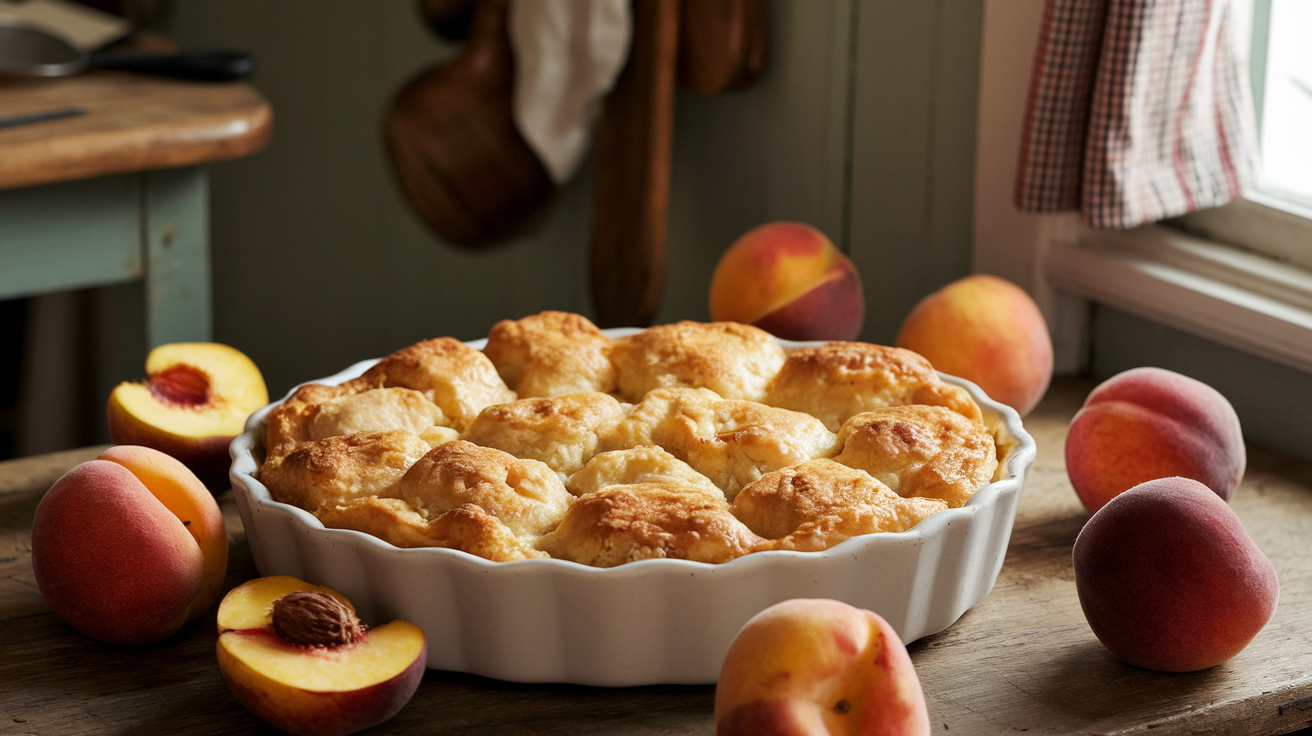Peach cobbler is a beloved dessert that brings comfort and warmth, especially during the summer months when peaches are in season. But what if you want to make this dessert when fresh peaches aren’t available? Can you substitute fresh peaches for canned in cobbler? This article will explore the nuances of using fresh peaches instead of canned, offering insights, tips, and recipes to help you create the perfect peach cobbler, regardless of the season.
Can You Substitute Fresh Peaches for Canned in Cobbler? Understanding the Differences
Before diving into the substitution process, it’s essential to understand the differences between fresh peaches and their canned counterparts. These differences affect texture, flavor, and nutritional value, all of which influence the final result of your cobbler.
Texture and Consistency in Peach Cobbler
- Fresh Peaches: Fresh peaches have a firm, juicy texture that can vary depending on ripeness. When baked, they soften and release their juices, contributing to a luscious filling.
- Canned Peaches: Canned peaches are softer and more uniform in texture due to the canning process, which involves heating. They come in syrup or juice, which can add extra sweetness and liquid to your cobbler.
Flavor Profile of Fresh vs. Canned Peaches
- Fresh Peaches: Fresh peaches offer a vibrant, natural sweetness with a hint of tartness. The flavor can vary depending on the peach variety and ripeness.
- Canned Peaches: Canned peaches are often sweeter due to the syrup they are packed in. The canning process can slightly alter the flavor, making it less intense than fresh peaches.
Nutritional Value of Using Fresh Peaches
- Fresh Peaches: Fresh peaches are rich in vitamins A and C, fiber, and antioxidants. They are a healthier option if you’re watching your sugar intake.
- Canned Peaches: While still nutritious, canned peaches may contain added sugars and preservatives. However, they are convenient and available year-round.
Processing and Preservation of Fresh vs. Canned Peaches
Fresh peaches are perishable and need to be used quickly or preserved through freezing or canning. Canned peaches have a longer shelf life, making them a convenient option when fresh peaches are out of season. If you’re interested in the differences between fresh and canned peaches in various recipes, you can learn more about peach varieties here.
Pros and Cons: Can You Substitute Fresh Peaches for Canned in Cobbler?
When deciding whether to use fresh peaches in your cobbler, it’s essential to weigh the pros and cons.
Pros of Substituting Fresh Peaches in Cobbler
- Enhanced Flavor and Aroma: Fresh peaches offer a more intense flavor and fragrance, enhancing the overall taste of your cobbler.
- Better Control Over Sugar Content: Using fresh peaches allows you to control the amount of sugar added, which is beneficial if you’re watching your sugar intake.
- Seasonal Freshness: Fresh peaches are at their peak during the summer, providing a delightful, juicy texture that canned peaches can’t replicate.
Cons of Substituting Fresh Peaches in Cobbler
- Preparation Time: Fresh peaches require peeling, pitting, and slicing, which can be time-consuming compared to the ready-to-use canned variety.
- Seasonal Availability: Fresh peaches are only available during specific months, limiting your ability to make peach cobbler year-round.
- Variability in Ripeness and Texture: The ripeness of fresh peaches can vary, which may affect the consistency of your cobbler.
If you’re interested in learning how to peel and slice peaches easily, check out this detailed guide.
How to Substitute Fresh Peaches for Canned in Cobbler
Substituting fresh peaches for canned in a cobbler is entirely possible with a few adjustments. Here’s how you can do it successfully:
Step-by-Step Guide to Using Fresh Peaches in Cobbler
- Choose the Right Peaches:
- Opt for ripe, but firm peaches. Overripe peaches can become too mushy when baked, while underripe peaches may not soften enough.
- Peeling and Slicing Fresh Peaches:
- To peel peaches easily, blanch them in boiling water for 30 seconds, then transfer them to ice water. The skins should slip off effortlessly. Slice the peaches evenly to ensure consistent cooking.
- Adjusting Sugar Content for Fresh Peaches:
- Fresh peaches are less sweet than canned peaches in syrup. Depending on your taste preference, you might need to add 1/4 to 1/2 cup more sugar to your cobbler filling.
- Cooking Fresh Peaches Before Baking:
- If your recipe calls for canned peaches, consider pre-cooking fresh peaches on the stovetop with a bit of sugar and lemon juice. This step helps to release their juices and softens the fruit, mimicking the texture of canned peaches.
Recipe Modifications When Using Fresh Peaches
- Adjusting for Liquid Content in Cobbler:
- Fresh peaches will release more juice as they bake. To avoid a runny cobbler, consider adding a thickener like cornstarch or flour to the peach mixture.
- Adjusting Baking Time and Temperature for Fresh Peaches:
- Fresh peaches may require a slightly longer baking time than canned due to their firmer texture. Keep an eye on the cobbler to ensure the top is golden brown and the filling is bubbling.
- Incorporating Spices and Flavors with Fresh Peaches:
- Fresh peaches pair well with spices like cinnamon, nutmeg, and ginger. You can also add a splash of vanilla or almond extract to enhance the flavor.
Recipes Using Fresh Peaches in Cobbler
Whether you’re a traditionalist or someone who enjoys experimenting in the kitchen, there are numerous ways to use fresh peaches in cobbler.
Classic Fresh Peach Cobbler Recipe
A traditional cobbler made with fresh peaches captures the essence of summer. Here’s a basic recipe:
- Ingredients:
- 6-8 fresh peaches, peeled and sliced
- 1/2 cup sugar (adjust based on peach sweetness)
- 1 tablespoon lemon juice
- 1 teaspoon cinnamon
- 1 tablespoon cornstarch
- 1 cup flour
- 1/2 cup butter, melted
- 1 cup milk
- 1 tablespoon baking powder
- Instructions:
- Preheat your oven to 375°F (190°C).
- In a bowl, mix peaches, sugar, lemon juice, cinnamon, and cornstarch.
- Pour the peach mixture into a greased baking dish.
- In another bowl, combine flour, baking powder, and milk to form a batter.
- Pour the batter over the peaches and drizzle with melted butter.
- Bake for 40-45 minutes until the top is golden brown and the filling is bubbly.
Southern-Style Peach Cobbler with Fresh Peaches
Southern-style cobbler is known for its rich, buttery crust and thick filling. Here’s how to make it with fresh peaches:
- Ingredients:
- 6 cups fresh peaches, peeled and sliced
- 1/4 cup brown sugar
- 1 teaspoon cinnamon
- 1/2 teaspoon nutmeg
- 1/4 cup butter
- 1 cup self-rising flour
- 1 cup milk
- Instructions:
- Preheat the oven to 350°F (175°C).
- In a large saucepan, combine peaches, brown sugar, cinnamon, and nutmeg. Cook over medium heat until peaches are soft.
- Pour the peach mixture into a baking dish.
- In a separate bowl, mix flour and milk to create a batter.
- Pour the batter over the peaches and dot with butter.
- Bake for 45 minutes, until the crust is golden.
Modern Variations of Peach Cobbler Using Fresh Peaches
If you enjoy experimenting, try these variations using fresh peaches:
- Peach and Berry Cobbler: Combine fresh peaches with blueberries or raspberries for a tart twist.
- Gluten-Free Peach Cobbler: Use almond flour or a gluten-free baking mix for a gluten-free version.
- Vegan Peach Cobbler: Substitute butter with coconut oil and use almond milk in place of regular milk.
Tips for Successfully Substituting Fresh Peaches for Canned in Cobbler
Making a perfect peach cobbler with fresh peaches requires a bit of knowledge and preparation. Here are some tips to help you get the best results:
Selecting the Right Peaches for Cobbler
- Varieties that Work Best: Freestone peaches are ideal for cobblers because they are easier to pit and slice. Clingstone peaches work too but may require more effort to prepare.
- Signs of Ripeness: Choose peaches that yield slightly to pressure and have a fragrant aroma. Avoid peaches with green undertones, as they may be underripe.
Handling Overripe or Underripe Peaches in Cobbler
- Overripe Peaches: If your peaches are too soft, you can still use them, but reduce the sugar in your recipe to account for their increased sweetness. They may also require less cooking time.
- Underripe Peaches: If your peaches are underripe, you can ripen them at home by placing them in a paper bag at room temperature for a couple of days.
Balancing Sweetness and Acidity in Peach Cobbler
- Fresh peaches can vary in sweetness. If your peaches are very sweet, reduce the sugar in your recipe. For tart peaches, consider adding a bit more sugar or honey.
Preventing Browning in Fresh Peaches
- Fresh peaches can brown quickly once peeled. To prevent this, toss them in a mixture of lemon juice and water or sprinkle with ascorbic acid (vitamin C) powder.
FAQs on Substituting Fresh Peaches for Canned in Cobbler
Here are some frequently asked questions about using fresh peaches in cobbler:
Can I use frozen peaches instead of fresh?
Yes, frozen peaches can be used if fresh peaches are unavailable. Thaw and drain them before use, and adjust the sugar content as frozen peaches can be sweeter.
How do I store fresh peaches if I’m not using them right away?
Store fresh peaches at room temperature until they ripen. Once ripe, refrigerate them to extend their shelf life for up to a week.
What’s the best way to peel peaches easily?
To peel peaches easily, blanch them in boiling water for 30 seconds, then transfer to an ice bath. The skins should slip off effortlessly.
Do I need to pre-cook fresh peaches before using them in cobbler?
Pre-cooking fresh peaches can help release their juices and soften the fruit, ensuring they have a similar texture to canned peaches in the final dish.
Can I use fresh peaches in a slow cooker cobbler recipe?
Yes, fresh peaches work well in slow cooker cobbler recipes. They will cook down nicely, but you may need to add a thickener like cornstarch to prevent the cobbler from becoming too runny.
How do fresh peaches affect the cobbler’s texture compared to canned?
Fresh peaches provide a firmer texture and more vibrant flavor compared to canned. However, they can make the cobbler juicier, so it’s essential to manage the liquid content in the recipe.
Conclusion: Can You Substitute Fresh Peaches for Canned in Cobbler?
Using fresh peaches in your cobbler can elevate the flavor, texture, and overall enjoyment of this classic dessert. While it may require a bit more preparation, the result is well worth the effort. Whether you’re following a traditional recipe or experimenting with new variations, substituting fresh peaches for canned in cobbler allows you to create a dessert that is not only delicious but also tailored to your taste preferences.
Remember, the key to a perfect cobbler is balance—balancing sweetness, texture, and cooking time. With the tips and insights provided in this article, you’re now equipped to make the best peach cobbler using fresh peaches. So go ahead and enjoy this timeless dessert with a fresh twist!


